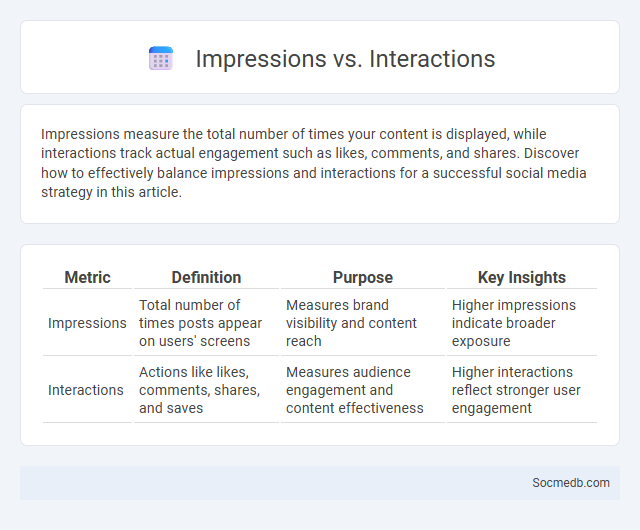
Photo illustration: Impressions vs Interactions
Impressions measure the total number of times your content is displayed, while interactions track actual engagement such as likes, comments, and shares. Discover how to effectively balance impressions and interactions for a successful social media strategy in this article.
Table of Comparison
| Metric | Definition | Purpose | Key Insights |
|---|---|---|---|
| Impressions | Total number of times posts appear on users' screens | Measures brand visibility and content reach | Higher impressions indicate broader exposure |
| Interactions | Actions like likes, comments, shares, and saves | Measures audience engagement and content effectiveness | Higher interactions reflect stronger user engagement |
Understanding Impressions: Definition and Importance
Impressions on social media represent the total number of times your content is displayed to users, regardless of whether it is clicked. This metric is crucial for measuring brand visibility and the potential reach of your posts across platforms like Facebook, Instagram, and Twitter. Understanding impressions helps you gauge awareness and optimize your content strategy to increase engagement effectively.
What Are Interactions? Key Distinctions
Interactions on social media encompass user engagements such as likes, comments, shares, and clicks that signal active participation with content. These interactions differ from passive actions like views or impressions, which indicate content exposure without user response. Understanding these key distinctions helps marketers measure genuine audience engagement and optimize content strategies for increased visibility and impact.
Impressions vs Interactions: Core Differences
Impressions on social media measure the total number of times a post is displayed, indicating potential reach, while interactions represent the actual engagement such as likes, comments, shares, and clicks, reflecting user involvement. Understanding the core difference between impressions and interactions helps marketers assess both visibility and audience engagement effectively. High impressions with low interactions may signal content visibility without meaningful engagement, guiding strategy adjustments for better user interaction.
Types of Impressions in Digital Marketing
Social media impressions in digital marketing include organic impressions, which occur naturally through unpaid content exposure, and paid impressions generated via targeted advertising campaigns. Viral impressions result from users sharing content, amplifying reach exponentially across networks. Earned impressions derive from user engagement such as likes, comments, and shares, enhancing brand visibility through authentic interactions.
Measuring User Interactions: Metrics and Methods
Measuring user interactions on social media involves analyzing key metrics such as engagement rate, click-through rate, and conversion rate to evaluate content effectiveness and audience response. Methods include tracking likes, comments, shares, impressions, and time spent on posts using analytics tools like Facebook Insights, Twitter Analytics, and Instagram Insights. Advanced techniques incorporate sentiment analysis and heatmaps to gain deeper insights into user behavior and optimize social media strategies.
Why Impressions Matter in Social Media Campaigns
Impressions in social media campaigns represent the total number of times your content is displayed, reflecting its reach and visibility to your target audience. High impression counts increase the chances of attracting potential customers and boosting brand awareness. Understanding the significance of impressions helps you optimize content strategy to maximize engagement and campaign effectiveness.
Evaluating ROI: Impressions and Interactions Compared
Measuring social media ROI requires analyzing both impressions and interactions to gauge campaign effectiveness. Impressions indicate the reach and visibility of content, while interactions, including likes, comments, and shares, reflect audience engagement and brand affinity. Comparing these metrics helps marketers assess the balance between exposure and active user participation, optimizing strategies for higher conversion rates and improved return on investment.
Best Practices for Maximizing Impressions
To maximize impressions on social media, consistently post high-quality, engaging content tailored to your target audience's interests and behaviors. Utilize platform-specific features such as hashtags, stories, and reels to increase visibility and encourage interaction. You should also analyze performance metrics regularly to refine your strategy and post during peak engagement times for optimal reach.
Strategies to Increase User Interactions
Implement targeted content strategies by analyzing your audience's preferences and behaviors to create engaging posts that resonate with their interests. Use interactive features such as polls, quizzes, and live videos to encourage active participation and foster a sense of community. Consistently engage with your followers through timely responses and personalized interactions to build trust and increase your social media user interactions.
Interpreting Analytics: Balancing Impressions and Interactions
Interpreting social media analytics requires balancing impressions and interactions to gauge content effectiveness accurately. High impressions indicate visibility, but strong interactions such as likes, comments, and shares reveal deeper audience engagement and content resonance. Optimizing strategies based on this balance enhances brand presence and drives meaningful user connections.
 socmedb.com
socmedb.com